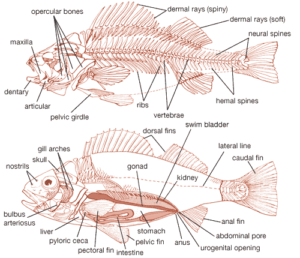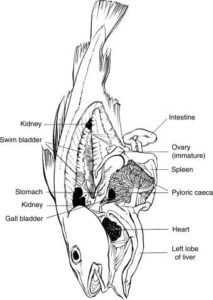Back to: ZOOLOGY 300 Level
WELCOME TO CLASS!
It’s great to see your bright mind back here today! You’re doing well, and I’m proud of how you’re taking your studies seriously. Today, we’ll be talking about four essential features in fish biology that help them survive, move, and reproduce in their watery world—skeleton, swim bladder, gills, and reproduction.
Skeleton, Swim Bladder, Gills, Reproduction
Now imagine you’re watching catfish swimming in the clear waters of a river in Benue, or tilapia gliding through a pond in Ogun. You may not see all that’s going on inside them, but their bodies are full of smart systems working together to keep them alive and active. Let’s go beneath the surface and discover how these systems work.

Skeleton
The fish skeleton forms the support structure of the body, just like in humans—but there’s more to it.
- Cartilaginous fish (like sharks and rays) have skeletons made of cartilage, a flexible but strong tissue. This makes their bodies lighter and helps them swim faster.
- Bony fish (like catfish and tilapia) have skeletons made of true bones. These bones give better protection to internal organs and provide support for muscle attachment.
Fish skeletons are designed to support movement in water. The vertebral column allows for flexibility, while the fins are supported by bony or cartilaginous rays that help in steering, balance, and swimming.
Swim Bladder
This is a gas-filled sac found in most bony fish. It helps them control buoyancy—that is, their ability to float or sink in water.
- When a fish wants to float, it adds gas to the bladder.
- When it wants to sink, it releases some gas.
It’s like an in-built life jacket. Cartilaginous fish like sharks do not have swim bladders. Instead, they rely on large oily livers and constant movement to stay afloat.
In Nigerian waters, fish farmers must understand how swim bladders work because problems with this organ can cause farmed fish to lose balance and float upside down.
Gills
Gills are the breathing organs of fish. They allow fish to extract oxygen from water and release carbon dioxide.
- Water enters through the mouth, flows over the gill filaments, and exits through the gill slits or openings.
- Inside the gills are thin-walled filaments full of blood vessels, which absorb oxygen from the water.
- Fish need to keep water flowing over their gills to breathe—some do this by swimming constantly.
Gills are so efficient that fish can live in oxygen-poor waters—as long as the water keeps moving. That’s why stagnant, dirty ponds often cause fish deaths in local aquaculture setups.
Reproduction
Fish reproduce in different ways depending on their species.
- External fertilisation: Most fish, like salmon and tilapia, release eggs and sperm into the water. Fertilisation happens outside the body.
- Internal fertilisation: Some fish, like sharks and guppies, fertilise eggs inside the female’s body.
Modes of development include:

- Oviparous: Laying eggs that hatch outside (e.g., most bony fish).
- Ovoviviparous: Eggs develop and hatch inside the body, and young are born alive (e.g., some sharks).
- Viviparous: Young develop inside the female and are nourished like in mammals (e.g., some rare fish species).
Many fish, like the African catfish, produce thousands of eggs in one breeding season. This ensures that even if many are eaten or lost, enough survive to keep the species going.
In Nigeria, fish farming practices like artificial breeding (hypophysation) make use of this by extracting eggs and milt, mixing them by hand, and incubating them in hatcheries.
Summary
- Fish can have bony or cartilaginous skeletons that support movement and structure.
- The swim bladder helps most bony fish control buoyancy and stay at the right depth.
- Gills extract oxygen from water and are essential for aquatic breathing.
- Fish reproduce in various ways—through external or internal fertilisation, and as egg-layers or live-bearers.
Evaluation
- What is the main difference between cartilaginous and bony fish skeletons?
- Explain how the swim bladder works.
- Why don’t sharks have swim bladders?
- Describe the structure and function of fish gills.
- Name and explain two types of reproduction in fish.
You’ve just discovered how fish manage to swim, breathe, and reproduce beneath the water’s surface. These features may be hidden to the eye, but they are proof of nature’s brilliant design. Keep learning—you’re building knowledge that can help transform aquaculture, biodiversity conservation, and science right here in Africa.
